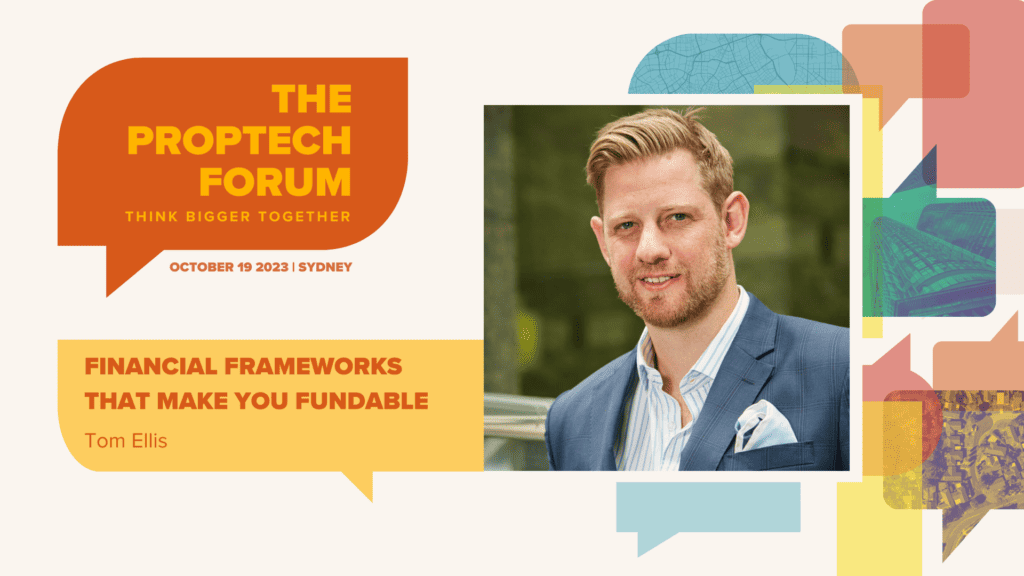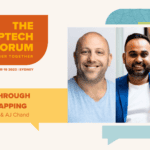Sure, you need to get your tech right, but one of the key differentiators between okay and stellar proptechs is how their founders focus on the finances.
Tom Ellis shares his 14 years of investment insights into the common mistakes made by proptechs looking for funding or exits and how to avoid them to think bigger about your business.
Kylie Davis
So Tom talk about your background in a way that doesn't involve puffer jackets, cigars or champagne and how you got into this area of Proptech funding and finance.
Tom Ellis
It's a long story that I'll shorten my sins and Pete's right on some of that, and probably more right than I'd like him to be. I was a banker, capital B, for a number of years and really got my entry in to private equity lending through the back end of the GFC. I was co managing a billion dollar debt portfolio and then helped launch the bank of Melbourne brand. So I was part of a change management team with some people from Bain Cap Gemini, very smart people, and then left, built a Martech workflow startup that we sold after 18 months. That's sort of the party line. The reality is we took some money from some people that were pretty vultureous, and we got out by the skin of our teeth. So that's probably for a story over a beer. And then I worked for a family office, and if anyone's not aware, large, wealthy families, sort of corporatize, they won't open investing once they're above $50 to $100 million of deployable assets.
Tom Ellis
So I worked for a Chinese billionaire for three and a half years, flying around the world, buying and selling companies. And then I've spent the last five years as a corporate advisor supporting transactions. One of those clients was a business called UbiPark. We assisted them with a capital raise, and Second Century Ventures and Reach were a cornerstone as part of that. And then I've ended up spending a lot more time with Peter and the team at Reach and coming on a couple of years now, we've invested in 25 businesses, I think, over the last three years, or a few we haven't announced yet. That's how I ended up here.
Kylie Davis
Awesome. Well, that's about three questions in one, but that's cool. So we all learn best usually when we do something wrong rather than we do something right. And I think your Martech story kind of hints at that. But what do you see when you're across the 25 Reach businesses that you've worked with, especially in the Proptech space? What are some of the key things that you've seen Proptech do wrong that you think could very easily be course corrected?

Tom Ellis
I think there's a couple of things in sort of picking up on themes of Naomi and Suzette touched on, and Carolyn as well, that sort of knowing listening to your customer and a few people I've seen go, Here is my customer. I will not move and go, here's what you're being asked for. And they go, no, I can't do that. So usually the responsiveness to customer, especially when you're trying to find that vein of enough customers that you can go deep enough in, when you're sort of more emerging, you look at everything and everything's a potential customer. But ignoring customers or not addressing the sort of the broader need is something I see people fall over on pretty quickly and the other is sort of pivoting too late. So again, on the feedback to the.
Kylie Davis
Market so when a prop tech is looking for funding, what are the things that you see that they need to do to make it go right?
Tom Ellis
I think I sort of have an interesting school of thought on this. Especially as a funder of companies, the best primary source of capital is customers. If you are getting customers, then you will get external funding tends to be what we see. That growth rate and that sort of proving a need that people are prepared to pay for is a proof point. And I think what people can improve upon is the communication around that. If you say, hey, my forecast is X and our process is taking a few months every month, make contact with your potential investors and say here is how we're going, we're there or thereabouts. So I think that people come into a conversation and think of it as a transaction, not a relationship. So that's probably the biggest thing I say people could improve upon.
Kylie Davis
And does that mean bootstrapping particularly or is it more just we're winning some customers and we've set 100 customer target and we're at 45, how are we going to hit the extra 55?
Tom Ellis
So I think a big thing for me as an investor is momentum and velocity. So going from one to two to ten, whether that's capital funded or through client funds, it's more that if you're showing someone is prepared to pay and there is a pathway to it being profitable at a point or the data being useful at a point, we're investing early and late, so it's kind of a barbell around some of these points. But I think it's the communication around that velocity and proving that people care or that you've explored an area and you're moving from B to D to C or whatever the thing is and providing a rationale for why. Because in lieu of that, we're investing in you guys as founders and how you think, how you operate and how the market responds to you. And probably the other thing is when things go bad, what do you do?
Tom Ellis
We've got some success stories in our global portfolio and a lot of it's when people have hit walls and there's a few faces in here that I know and it's not until you hit a wall that we see how people pick themselves up and that's often when the difficult discussions happen.
Kylie Davis
So without naming names, although I'm sure we won't names, without naming names, what are some of the biggest mistakes that you've seen that we can learn from?
Tom Ellis
I think it's really difficult because timing is something that people underprice. People always misprice luck. And luck is sort of a thing where pushing hard enough for long enough. There's this great kind of image of two people digging in a mine and one gives up an inch before the diamond, the other goes through. We've probably all seen that and laughed at it, but that's the reality. That sort of tenacity as a founder to find the way through. And I think also knowing when to quit on a strategy, on a belief, on a hire, on a funding. There's times when you've got to get back to just looking after the core, protecting yourself as a founder and as an investor and funder. We look to that. It's a long journey. It's not one check tomorrow, it's who's going to be there in 510 years. So I think that's probably the thing that I'd like people to take away.

Kylie Davis
When you meet a Prop tech for the first time, when they're pitching you, what do you look for? You must have a pretty good radar.
Tom Ellis
I think people often talk over me, which is no mean feat because I can talk underwater. And I think not listening is something that always gets me a bit cautious. I want to understand if that's how they're dealing with me as a potential stakeholder. How are they engaging with customers? You're probably seeing a theme here where I've mentioned customer every 2 seconds. That's because across the global reach and second century portfolio, there's 250 plus companies. And those that we've seen over that sort of amount of data that are succeeding are listening, engaging, working with customers. So if someone's trying to force their point or tell me that I'm not understanding, I may not be, but help simplify. And a lot of the work we do is distilling complicated messages into sort of simplified dot points. Because if it's not right for me, that's fine, but we can be not right and then have a conversation.
Tom Ellis
It doesn't mean that I dislike you or what have you. So I think that dialogue, rather than it being one way we're hearing a.
Kylie Davis
Lot today about the power of communication and relationships and the humanness of it all, as opposed to the tech side of it. What are the key pieces of advice that you give Proptech in The Reach cohort? Does it kind of fall into key categories?
Tom Ellis
I think that's part of the secret sauce of the whole team. We've got Ebony and Pete and we've got some support globally. And I think it'd be remiss of me to distill it into a sentence in this forum, but I think it's partnership. Partnership is the big thing. So listening to each person's unique need and adapting relative to that. If we've got a business and there's a number of our cohort here today that might be in consumer markets versus construction, I can't give the same thing. But we talk a lot about active listening and communication. I think that's probably the biggest thing that any investor should be talking to.
Kylie Davis
When founders are looking at going down the funding path, what's the thing that they misunderstand the most or what's the hardest to grasp?
Tom Ellis
Yeah. The model is very important. The economics of your business, whether what it is today or in future, as an investor, I need to understand what you believe to be true, and then what I believe, you believe, if that makes sense. So how much conviction can I have in your forecast? And if you go, pocky, stick up it to the right. And then I go, well, all right. That means you're going to increase your customer charge from $8 to 700 per customer. Just help me bridge that. So the logic that goes into a model and the discussion around it, and that's probably my banking career. It's not that the number moved from ten to 20. It's the why I actually care about whether it went from ten to 20. Scott, we worked together a long time ago, and you've heard me talk about that for 15 years.
Tom Ellis
It's the why because what I want to know is, do you understand the levers in your business? How does that relate to the market and what the market is telling me? US, our network, who are the peers that I can lean on to go, will the market tolerate this pricing? And I think that's probably the piece that a lot more fiction is written in XL than word. Right.
Kylie Davis
I'm keeping that.
Tom Ellis
And remember, I do buyouts for a living. So I think it's, what do you hold to be true and how do you justify it? And then if we say, what if it doesn't, what does it mean? The question I ask people is, what does failure look like? And if people go, I shut the door, I tend to be less interested. You can sort of see the fire in some people, and a lot of the founders were backed. It's a personal thing where they go, oh, no, this is my mission, or I believe in this because or, no, can't you see the market needs this so that if it's not going to be accepted by those ten people, there's another thousand behind it. And I think the depth of market and that's what I mean by model, it's not just dollars and cents, it's the macro environment of if you get 4% of a $10 million market, I'm not that interested.
Tom Ellis
Get 4% of a $10 billion market or 2% in a small market, you can be out competed in a bigger.

Kylie Davis
Market, there's other levers funding, and going down the investor path is still fairly new for Australia. What role do you think our experience as Australian and Kiwi businesses have around know, how do we compare to the US and how can we get better at?
Tom Ellis
So I've just been in San Diego for about a week and catching up with some of our businesses globally have raised sort of several hundred million, and some of our Australian businesses that have raised a lot less australians are typically capital efficient. That's investment nerve for good at sort of doing it cheap and sort of not experimenting as much. I think the piece that Australians struggle with is putting themselves up in lights enough to go, here's the bhag like Naomi did this morning, getting it down to one experience a second. What is that? And then how do you bridge it back today and tomorrow? What's the crawl walk run of that? A lot of our US parties are kind of really clear on here's the blue sky here's today, I'll get the half, step through your money, then I'm going to get some other money.
Tom Ellis
So don't mishear that. I'm saying customer funds are the only source. It's that if I believe they will come, or an investor believes that you don't necessarily have to be viable if you can be fundable. So you can go, well, that unlocks this. Or here's where the other pieces come. So the storytelling in Australia is always a bit overbaked in the technical and not clear enough on the reality of the today, tomorrow, next year.
Kylie Davis
And that comes down again back to that communication piece and that relationship and understanding customers and adoption and believability.

Tom Ellis
Everyone sends me something saying there's a tam of a trillion dollars or using the markets around the Australian property size. That's interesting, but do you really understand where you're playing? So I think just pausing and saying, this is where we play. We know this because we often trust the experiences where you see Canberra and Atlassian teams get funded. If you've been around high performing people and you understand things in the market or you've got property experience, call that out. Because there's a lot of people that have built tech to some of the points around fintech and they've kind of gone tech first, problem later. And I think understanding and listening to customers or being able to show evidence that you can is really important.
Kylie Davis
Cool. So, last question. I know this comes up a lot. What is the ideal amount of funding to raise and what's the right mix of shareholders and investors? Like, how do you avoid losing everything in your business?
Tom Ellis
It's a big caveat. It depends. And I won't give personal financial advice. I've never, in my experience had anyone go, I raised too much money. No one has ever said to me, gee, I wish I'd have raised less ever. No one's ever gone, we could have done it with half the amount. I think there's always more to spend on, but I think the right number of shareholders ideally is one or none, but it's the right number to get you to the gate. Ownership is something people get hung up on around 2%, 10%, 100%. I think it's around the mission, the value you create and how you get there together. There's a business named Knock in the US. They were going to IPO. They're part of our broader global portfolio. It's going to be the $2 billion IPO. The founder got crushed down with 200 and plus mil of debt.

Tom Ellis
This is all public, so I can comment on it. And their effective equity got really heavily compressed. They were an integral part of that business. So as part of recapitalizing it, they were granted a whole host of options that brought them back up to a material threshold. If you are solving a problem and you're critical to the business, there is always money to be made. I think arguing about a percent here or there versus the right parties that will back you when things are difficult. But I guess the other side of that is if you're a founder and you've got sort of sub 10%, you're looking to raise money that starts to raise flags. If it's sort of looking for several million dollars because it's how much incentive will you as a founder have in 3510 years? You'll hear that kind of timeline and relationship are two things I keep mentioning.
Tom Ellis
And we just look for that alignment.
Kylie Davis
Awesome. So, Tom, thank you so much.



